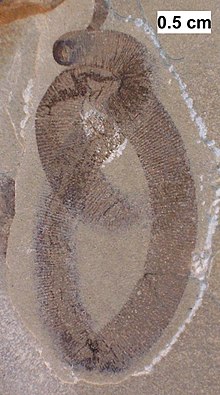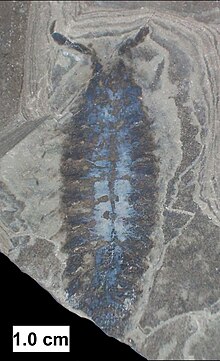Waukesha Biota: Difference between revisions
Kennethcgass (talk | contribs) Created article. |
(No difference)
|
Revision as of 22:07, 3 February 2020
| Waukesha Biota | |
|---|---|
| Stratigraphic range: Early Silurian (Telychian, c.438 Ma) to Sheinwoodian, c.433 Ma) | |
| Type | Geological formation |
| Unit of | Brandon Bridge Formation |
| Area | Two quarries 32km apart |
| Thickness | 12 cm |
| Lithology | |
| Primary | Finely laminated, interbedded mudstone and dolostone |
| Location | |
| Coordinates | 43°00’42’’N 88°13’54’’W and 42°53’57’’N 88°0’8’’W |
| Region | Waukesha County, Wisconsin and Franklin, Milwaukee County, Wisconsin |
| Country | USA |
| Extent | Very limited |
| Type section | |
| Named for | Waukesha County, Wisconsin; not to be confused with the Waukesha Formation, which overlies the Brandon Bridge Formation. |
The Waukesha Biota is a Konservat-Lagerstätte of Early Silurian (Telychian) to Sheinwoodian) age located within the Brandon Bridge Formation in Waukesha County and Franklin, Milwaukee County, Wisconsin.[1] It is known for the exceptional preservation of its diverse, soft-bodied and lightly skeletonized taxa, including many major taxa found nowhere else in strata of similar age. [2]

History and significance
Prior to the discovery of the Waukesha Biota, very little was known about the soft-bodied animals that were sure to have lived in the Silurian seas. Thanks to the famous Burgess Shale of the Canadian Rockies, we knew that the seas were already teaming with soft-bodied and lightly skeletonized animals as far back as the Cambrian, yet very few were preserved in later Paleozoic rocks. This is because the fossil record is greatly skewed toward biomineralized skeletal remains. The announcement of the Waukesha Biota in 1985 thus marked a major turning point in our knowledge of Silurian life. In his popular book, ‘’Wonderful Life’’, Stephen Jay Gould compares the “anatomical disparity” of the Burgess Shale with only five other occurrences in the world---one of which was the Waukesha Biota, which he referred to as the “Brandon Bridge fauna”---and none of the others were Silurian. [3] Other “soft-bodied” Silurian sights have turned up in more recent years, but none have produced the high diversity of soft-bodied animals observed in this biota. [4][5]
The exceptional preservation of the Waukesha Biota’s fossils thus provides a window to a significant portion of Silurian life that otherwise may have been undetected and therefore unknown to science. [6]
Stratigraphy and depositional environment
The Waukesha Biota is preserved within a 12cm layer of thinly-laminated, fine-grained, shallow marine sediments of the Brandon Bridge Formation consisting of mudstone and dolostone deposited in a sedimentary trap at the end of an erosional scarp over the eroded dolostones of the Schoolcraft and Burnt Bluff Formations. Fossils of unambiguous , fully terrestrial organisms are lacking[1][7] Most of the Waukesha Biota fossils were found at a quarry in Waukesha County, Wisconsin, owned and operated by the Waukesha Lime and Stone Company. Other fossils were collected from a quarry in Franklin, Milwaukee County, owned and operated by Franklin Aggregate Inc. That quarry lies 32km south of the Quarry in Waukesha. The Franklin fossils were from blasted material apparently originating from a horizon and setting equivalent to that of the Waukesha site. Its biota is similar to that from the Waukesha site, except that it lacks trilobites.[5]
Taphonomy
The Waukesha Biota is unusual in preserving few of the kinds of animals that typically dominate the Silurian fossil record, including in other strata of the same two quarries. Fossils of corals, echinoderms, brachiopods, bryozoans, gastropods, bivalves, and cephalopods are rare or absent from the Waukesha Biota, although trilobites are diverse and common.]].[1][5]
About 60cm above the strata that contain the Waukesha Biota at the Waukesha site are preserved a noncalcified dasycladalean alga (Heterocladus waukeshaensis)[8]
and several species of graptolites. Due to their exceptional state of preservation, the strata containing those fossils were originally considered to be part of the Waukesha Biota. However, Wendruff (2016) considers that higher occurrence to be a separate Lagerstätte. [5]
The exceptional preservation of non-biomineralized and lightly skeletonized remains of the Waukesha Biota is generally attributed to a combination of favorable conditions, including the transportation of the organisms to a sediment trap that was hostile to predators but favorable to the production of organic films that coated the surfaces of the dead organisms, which inhibited decay, sometimes enhanced by promoting precipitation of a thin phosphatic coating, which is observed on many of the fossils. [1][2][9][10][7][5][11]
Biota
Arthropods
The fossil record of the Waukesha Biota is dominated by arthropods, both in number of fossils and number of species. [4] This is even true when excluding trilobites, which in most Early Paleozoic marine biotas are the source of the vast majority or all of the arthropod fossils. This is due to preservational conditions which protect soft and lightly skeletonized tissues from decomposition but select against biomineralized skeletal remains. [1][5]
Scorpions
Two fossils of an arthropod preserving internal organs have been identified as a scorpion and named Parioscorpio venator, which if correctly identified is the oldest scorpion in the fossil record. One of the fossils preserves internal organs, but because respiratory structures are not preserved in the either specimen, it is not certain whether the animal was marine, terrestrial or amphibious. [7]
Synziphosurines
Also known as horseshoe crabs, xiphosures are represented in the Waukesha Biota by several specimens of a synziphosurine (a primative group of xiphosure) which has been named Venustulus waukeshaensis. It is the earliest known synziphosurine. [1][9]
Thylacocephalans
Thylacares brandonensis has been named for what is recognized as the oldest unequivocal thylacocephalan, which is an enigmatic group of crustaceans having a pair of raptorial appendages and a bivalved shield that encloses most of the body. [1][12]
Phyllocarids
Three species of phyllocarid crustaceans are found in the Waukesha Biota, consisting of Ceriatocaris macroura, C. papilio, and C. pusilla. Although they are not new to science, they preserve their delicate appendages and further show the diversity of the lightly biomineralized fossils of the Waukesha Biota.[11]
Cheloniellids
Common in the Waukesha Biota is an arthropod that has a pair of large raptorial appendages. [1] It has been identified as a new and the best preserved member of the enigmatic arthropod group known as the cheloniellida. [5] Although the taxon was given a name, the manuscript has not been peer reviewed, and the name is therefore not officially recognized.

Other arthropods
Other kinds of arthropods having varying degrees of biomineralization of its skeletal elements are also present in the Waukesha Biota, including leperditicopid ostracods (crustacea), and about thirteen species of trilobites, several of which are new. Some trilobite taxa preserve their digestive tracts. An unnamed dalmanitid is commonly found with its dorsal exoskeleton intact and sometimes seen in such numbers that they cover large surfaces of sediment. [1][5]
Some taxa do not readily fit within existing arthropod groups, such as the very common “butterfly animal,” which appears to have two wing-like extensions at its sides, but may be another enigmatic bivalved arthropod. [1][5]


Anomalocaridid?
A fossil resembling the grasping appendage of an anomalocaridid was found among the Waukesha Biota material. [5] If this identification proves true, the specimen would be the first Silurian occurrence of an anomalocaridid.[13]
Lobopods
Several unnamed species of lobopods are known from the Waukesha Biota. [1][5] Some of these were originally thought to be myriopod arthropods until further study revealed key lobopod characteristics. [10]
Annelid worms
Many exquisitely preserved annelid worm fossils, some preserving digestive tracts, are part of the Waukesha biota. These include Palaeoscolecids, an aphroditid polychaete, a spiny polychaete, and a possible leech. [1][5] Scolecondonts, which are the jaws of polychaete worms, have also been found. [1]
Chordates
A fossil of the conodont animal, the primitive, eel-like chordate now known to be the source of small, phosphatic, tooth-like structures long-used in the dating of strata, has also been found. An assemblage of phosphatic conodont elements were found associated with this fossil. The Waukesha Biota was only the second locality to produce a conodont animal. [1][14][15] Numerous, well-preserved chordates that may also be conodont animals were later found in the Waukesha Biota of Franklin Quarry. [5]
Cubozoan
A single, nonmineralized body fossil has been identified as a cubozoan cnidarian.
Other animal taxa
The Waukesha Biota includes fossils of many fragmentary, unidentifiable, nonbiomineralized and lightly biomineralized skeletal elements that may belong to additional taxa. It also includes uncommon fossils from certain biomineralized taxa, including conulariids, tabulate corals, brachiopods, cephalopods, and echinoderms. [1][5]
References
- ^ a b c d e f g h i j k l m n o Mikulic, D.G.; Briggs, D.E.G.; Kluessendorf, J. (1985). "A new exceptionally preserved biota from the Lower Silurian of Wisconsin, U.S.A." Philosophical Transactions of the Royal Society of London B. 311: 75–85.
- ^ a b Jones, W.T.; Feldman, R.M.; Schweitzer, C.E. (2015). "Ceratiocaris from the Silurian Waukesha Biota, Wisconsin". Journal of Paleontology. 89 (6): 1007–1021. doi:10.1017/jpa.2016.22.
- ^ Gould, S.J. (1989). Wonderful Life: The Burgess Shale and the Nature of History. New York: W.W. Norton & Company. ISBN 978-0-393-30700-9.
- ^ a b Kluessendorf, J. (1994). "Predictability of Silurian Fossil-Konservat-Lagerstätten in North America". Lethaia. 27: 337–344.
- ^ a b c d e f g h i j k l m n Wendruff, A.J. (2016). Paleobiology and Taphonomy of Exceptionally Preserved Organisms from the Brandon Bridge Formation (Silurian), Wisconsin, USA. Ph.D dissertation, Ohio State University.
- ^ Gass, K.C. (2008). "The Waukesha Biota: A unique window to the Silurian world". Fossil News. 14 (12): 7–7.
- ^ a b c Wendruff, A.J.; Babcock, L.E.; Wirkner, C.S.; Kluessendorf, J.; Mikulic, D.G. (2020). "A Silurian ancestral scorpion with fossilised internal anatomy illustrating a pathway to arachnid terrestrialisation". Scientific Reports. 10 (14): 1–6.
- ^ LoDuca, S.T.; Kluessendorf, J.; Mikulic, D.G. (2003). "A new noncalcified dasycladalean alga from the Silurian of Wisconsin". Journal of Paleontology. 77 (6): 1152–1158.
- ^ a b Moore, R.A.; Briggs, D.E.G.; Braddy, S.J.; Anderson, L.I.; Mikulic, D.G.; Kluessendorf, J. (2005). "A new synziphosurine (Chelicerata: Xiphosura) from the Late Llandovery (Silurian) Waukesha Lagerstätte, Wisconsin, USA". Journal of Paleontology. 79 (2): 242–250.
- ^ a b Wilson, H.M.; Briggs, D.E.G.; Mikulic, D.G.; Kluessendorf, J. (2004). Affinities of the Lower Silurian Waukesha ‘Myriapod’. 2004 annual meeting of the Geological Society of America.
{{cite book}}: Cite has empty unknown parameter:|1=(help) - ^ a b Jones, W.T.; Feldman, R.M.; Schweitzer, C.E. (2015). "Ceratiocaris from the Silurian Waukesha Biota, Wisconsin". Journal of Paleontology. 89 (6): 1007–1021.
- ^ Haug, C.; Briggs, D.E.G.; Mikulic, D.G.; Kluessendorf, J.; Haug, J.T. (2014). "The implications of a Silurian and other thylacocephalan crustaceans for the functional morphology and systematic affinities of the group". BMC Evolutionary Biology. 14 (159): 1–15.
- ^ Giribet, G.; Edgecombe, G.D. (2019). "The phylogeny and evolutionary history of arthropods". Current Biology. 29 (xx): 592–602.
- ^ Smith, M.P., D.E.G. Briggs, & R.J. Aldridge (1987). [1] In R.J. Aldridge, ed., "Paleobiology of Conodonts". Chichester, UK: British Micropalaeontological Society Series, pp. 91-104.
- ^ Knell, S.J. (2013). The Great Fossil Enigma: The Search for the Conodont Animal. Bloomington, IN: Indiana University Press. p. 413. ISBN 978-0-253-00604-2.

